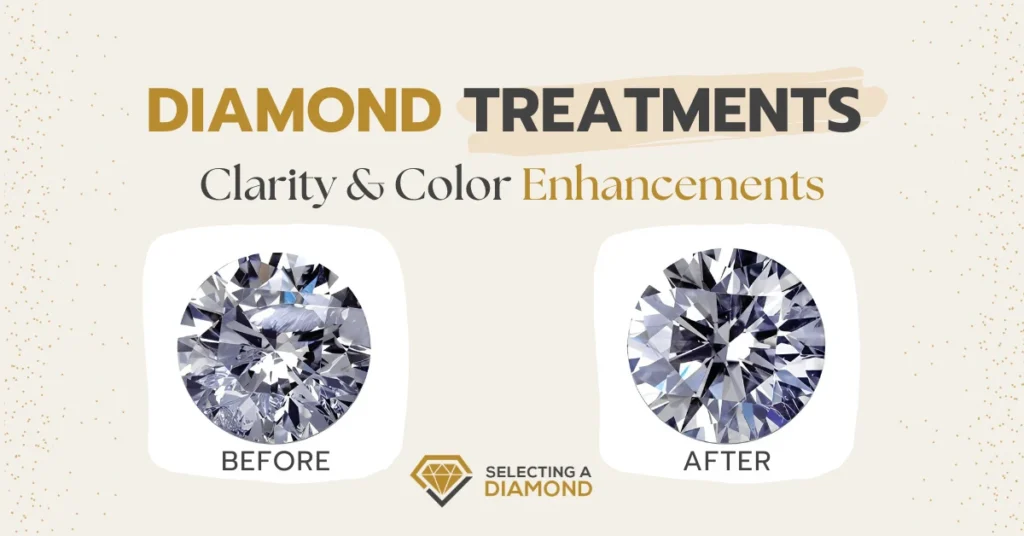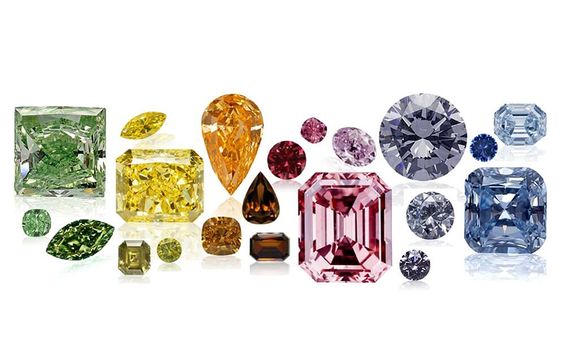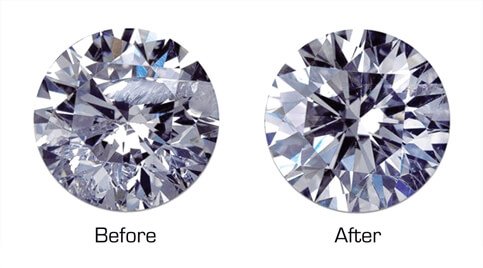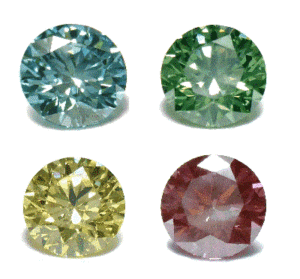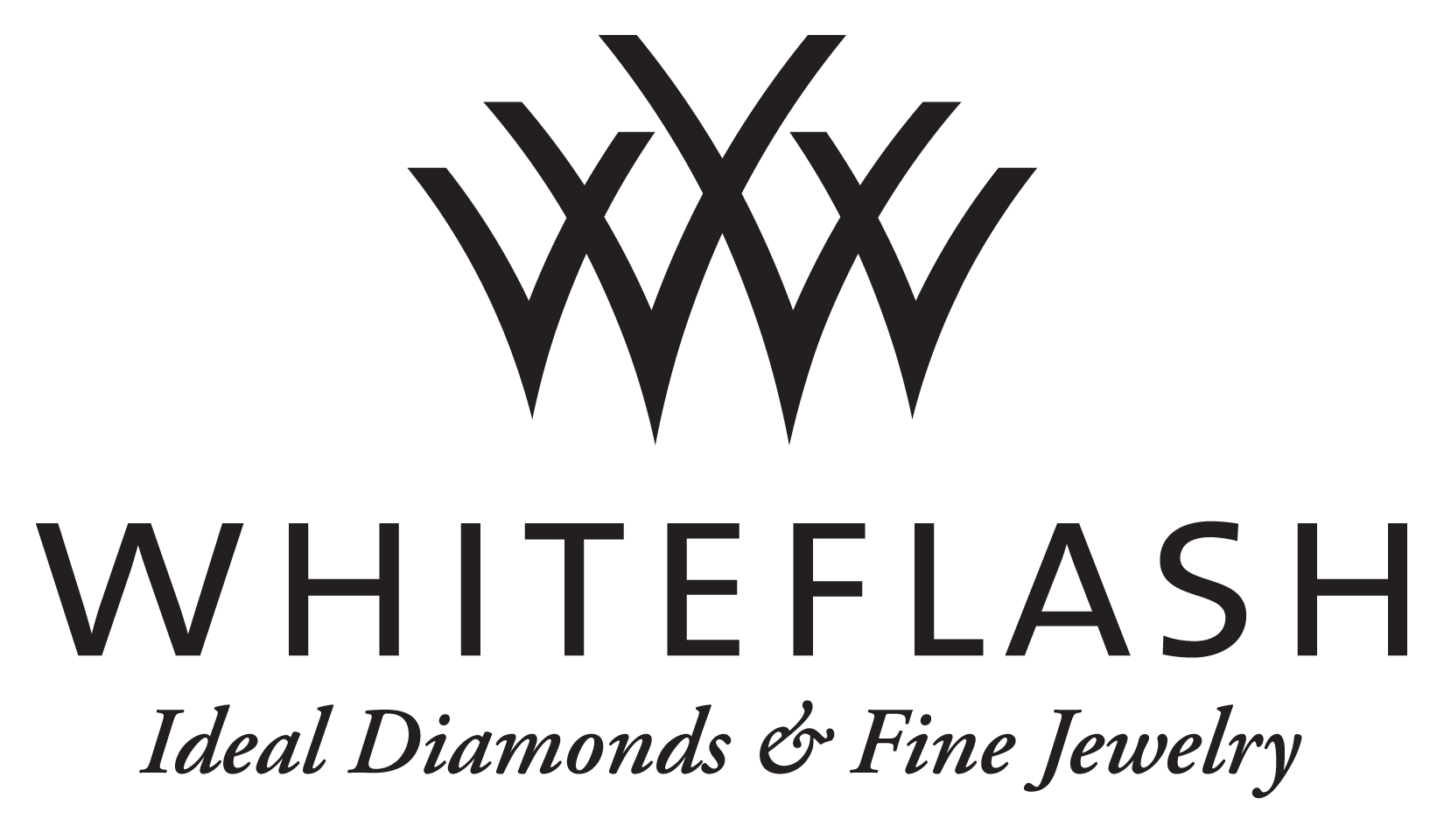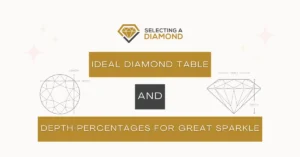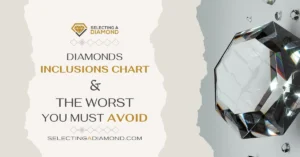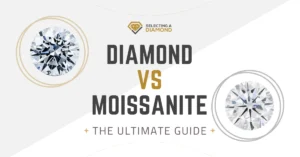We may earn a commission when you purchase through our affiliate links, at no extra cost to you. This helps support our work and allows us to continue providing unbiased, expert diamond advice.
Summary in a few lines:
Enhanced & treated diamonds are natural diamonds, which got some extra “care” to make them look beautiful.
Diamonds with “miserable” clarity grades, or colors that need to be intensified (or even changed), can benefit from diamond treatments.
Major online stores like James Allen & Whiteflash confirms that all their inventory of diamonds are not treated in a way or another.
Blue Nile is more or less on the same line, but with a slight difference we will see shortly.
In general, getting an enhanced diamond isn’t recommended, since most enhancement types aren’t permanent, and if you want an affordable diamonds, you can browse lab created diamonds on James Allen, after carefully reviewing our lab created diamonds guide.
What are Enhanced Diamonds?
Diamonds are nature’s marvels, formed from carbon that undergoes intense heat and pressure. This incredible transformation occurs between 87 to 120 miles beneath the Earth’s mantle.
The terms ‘Color Enhancement’, ‘Enhanced Diamonds’, and ‘Diamond Treatment’ are often used interchangeably. But what do they really mean? At their core, they describe the processes used to modify a diamond’s original clarity or color, aiming to elevate its beauty. Therefore, the diamond you see post-enhancement might not be in its original state concerning color or clarity.
Most discussions on diamond “enhancements” predominantly revolve around clarity. This is because clarity has a direct influence on how light interacts with the diamond. However, it’s crucial to understand that enhancements can impact both clarity and color.
Clarity Enhancements: These treatments often target critical inclusions that might be visible to the naked eye. The goal? To make them less obvious.
Color Treatments: These aim to modify a diamond’s color. This can mean either amplifying its inherent color or shifting it to make it appear more colorless, pure, and clear.
It’s worth noting that not all enhancements are equal. Some are permanent and improve the overall quality, while others might focus solely on color modification.
If you’re considering purchasing a diamond from reputable online retailers like James Allen or Whiteflash, you can be confident that you’re acquiring a natural, untreated diamond. This means no enhancements have been used to artificially boost its color or clarity grade, thus inflating its value.
However, a word of caution: Blue Nile, another renowned name in the industry, has stated that their colored gemstones undergo some form of treatment, excluding white and fancy color diamonds.
Leading grading laboratories, such as GIA & AGS, do not evaluate enhanced or treated diamonds. Hence, acquiring a diamond certified by GIA or AGS assures you of its natural and untreated state.
For those who appreciate rarity, diamonds can be found in every imaginable hue, including the extraordinarily rare shades of blue, green, pink, and red. These colors are truly nature’s masterpieces.
Natural colored diamonds are incredibly rare, leading to the introduction of color enhancements and diamond treatments. Indeed, treated and enhanced diamonds are genuine, originating from the earth.
Many turn to enhancements, seeking to rejuvenate their diamond’s appearance. Simply bring your diamond jewelry, whether it’s a necklace, earrings, ring, bracelet, or watch, to a jeweler for clarity treatment, and watch its sparkle return.
Why People Might Consider Enhanced/Treated Diamonds?
Price is often the main draw for people contemplating enhanced or treated diamonds.
Typically, these diamonds can be 30-40% less expensive than their natural counterparts. Sound familiar?
You might have observed a similar price drop with lab-created diamonds, which are also about 30% cheaper than natural ones. And here’s the kicker: lab-created diamonds often surpass enhanced diamonds in quality. In fact, they sometimes even rival the beauty of natural diamonds.
While the affordability of enhanced diamonds might seem alluring, there are superior alternatives available on trustworthy platforms.
Take Clean Origin, which boasts a collection of over 63,000 lab-created diamonds. James Allen isn’t far behind with their offering of over 50,000 lab-created stones.
Even Blue Nile, a colossal retailer that once resisted the lab-created diamond trend, has now jumped on the bandwagon, showcasing over 15,000 lab created diamonds for buyers.
How Diamonds Get Enhanced / Treated?
Diamonds undergo various treatments to boost their clarity, including:
- Laser drilling
- Fracture filling
- Internal laser treatment
For color enhancements, the treatments include:
- Irradiation
- Annealing
- Coating
- Heat treatment
- High-pressure high-temperature treatment (HPHT)
Let’s delve into each method to understand their impact on diamond clarity and color.
Clarity Enhancements
1. Laser Drilling Enhancement
Diamonds, while breathtaking, might have small inclusions that mar their flawless appearance. These dark blemishes can be either eradicated or lightened.
- Removal: Using a precise laser, tiny holes are drilled into the diamond, making the inclusions evaporate at the surface.
- Lightening: A bleaching agent helps to reduce the visibility of the inclusion.
Once subjected to laser drilling, a diamond’s value rises due to its enhanced clarity and superior quality.
2. Fracture Filling Enhancement
Being a gemstone, diamonds can sometimes have imperfections like cracks or dents. Fracture filling addresses these issues. The process involves filling the diamond’s imperfections with a material that mimics its optical properties, restoring its pristine appearance.
While this enhances the diamond’s visual appeal, it’s essential to note that the treatment isn’t permanent.
A keen observer might spot a fracture-filled diamond: it emits vibrant color flashes under certain lighting. Additionally, x-ray examinations can reveal the treatment, as fillers aren’t transparent like the diamond. This procedure can elevate a diamond’s clarity by up to two grades.
3. Internal Laser Enhancement
Unlike other treatments, internal laser treatments don’t leave a residual hole.
Instead, they may result in worm-like lines inside the diamond. This procedure is ideal for diamonds with dark inclusions and internal fractures.
The inclusion is lightened by boiling the diamond in acid under pressure. Detecting such treated diamonds requires specific lighting techniques and a high magnification microscope.
Color Treatment / Enhancement
1. Irradiation
Irradiation can transform diamonds into an array of colors such as green, blue, black, and yellow. The high-energy particles used in this process create color centers in the diamond. Depending on the type and duration of radiation, the diamond’s color can either be intensified or altered completely.
2. Annealing
Annealing involves a methodical heating and cooling of the diamond. This technique transforms the diamond’s color to shades of brown, orange, and more recently, pink, purple, and red.
The diamond undergoes a series of color changes as it’s heated. Once the desired hue is achieved, the process stops, and the diamond cools. Reheating the diamond post-annealing can introduce intense colors.
3. Coating
A colorless diamond can be given a new hue through a coating of thin material, such as silica.
This layer influences how the diamond refracts light, giving the illusion of a consistent new color. While durable, this coating isn’t everlasting and can deteriorate during polishing or repairs.
4. Heat Treatment
Heat treatment targets low-grade diamonds, placing them in a vacuum and exposing them to heat. This process prompts graphite deposits to form within the diamond’s fractures, resulting in black diamonds.
While most market-available black diamonds have been treated, methods exist to discern a diamond’s natural vs. treated color. This technique is also termed “graphite treatment.”
5. High Pressure High Temperature (HPHT)
HPHT stands out in its ability to diversify diamond colors, producing hues ranging from colorless and blue to pink, green, yellow, and everything in between.
HPHT is stealthy, detectable only in a well-equipped grading laboratory. This technique employs machines that subject diamonds to significant pressure and temperature levels, refining its crystalline structure.
HPHT, a lasting treatment, typically precedes annealing and irradiation processes.
Are Color/Clarity Enhanced Diamond Good or Bad?
A common query we encounter is the viability of investing $3k in a treated diamond.
To put it simply: it’s not a wise decision, and we generally advise against it.
The renowned diamond grading authority, GIA, has this stance on enhanced diamonds:
“GIA only issues reports for treated diamonds if the treatment they received, such as laser drilling or HPHT color enhancement, is stable or permanent. GIA discloses the presence of treatments on the report, and as a further precaution, laser-inscribes the girdles of diamonds it identifies as color-treated. All GIA reports designate a diamond’s color as Natural Color or Treated Color.” Source
The American Gem Society (AGS) aligns with this perspective. They don’t grade diamonds that have been subjected to alterations or treatments.
Consequently, if you opt for a treated diamond, it will most likely be graded by lesser-known labs. This raises concerns, given our consistent recommendation of sticking to GIA or AGS grading.
Further considerations include:
- Diamonds undergo a variety of treatments, aiming to enhance aspects like appearance, quality, clarity, or even to modify their color.
- Many of these treatments:
- Are not easily discernible outside a specialized grading lab.
- Don’t offer lasting results, with enhancements wearing off over time.
Summary
Many are drawn to enhanced diamonds primarily because of the price allure.
When set side by side with an untreated diamond of similar color and clarity, the cost savings on enhanced diamonds can be substantial, often ranging between 30%-50%. This price drop can be a golden opportunity for those who might otherwise find diamonds beyond their budget.
However, a lower price tag should not be an invitation to compromise on quality. Most color enhancements, barring HPHT, lack permanence. This means that if the diamond isn’t cared for meticulously, its hue might alter over time—a disheartening scenario for anyone who treasures their gemstone.
In a nutshell: Avoid the pitfalls of enhanced diamonds. Instead, equip yourself with knowledge on how to buy the best natural diamond without breaking the bank, or consider the burgeoning world of lab-created diamonds as a credible alternative.
Still not sure where to buy your diamond?
We always recommend shopping diamonds online and created a Full guide to shop diamonds like a Pro.
Among online retailers, here are our favorite stores click their logo to visit store
-
James Allen:
Our favorite online store, best diamond imaging technology available today, comes with the largest collection with more than half a million loose diamonds.
-
Blue Nile:
Widest collection of loose diamonds of all sizes, great imaging technology for most of their inventory (hundreds of thousands of diamonds), great customer support.
-
Whiteflash:
Home Of A CUT ABOVE® Super Ideal Diamonds, they stand out from the crowd by offering premium diamonds cuts, tailored to those who love the details, at great prices too.

